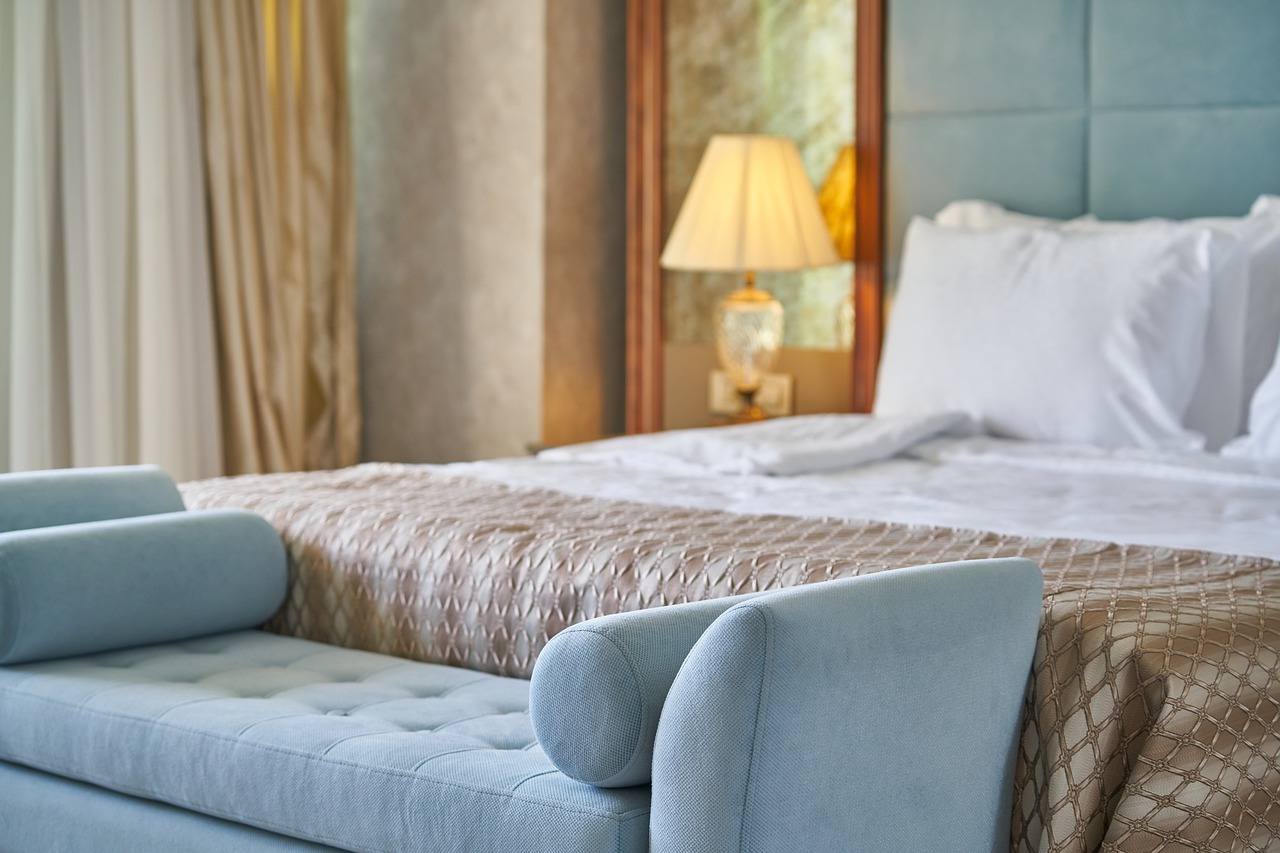非常感谢 袈蓝建筑 予gooood分享以下内容。更多关于他们,请至:SYN Architects on gooood
Appreciations towards SYN Architects for providing the following description:
溪园酒店项目位于北京平谷城区15公里外的金海湖国际度假区内,是袈蓝建筑为山水文园集团设计的一个高端度假村。酒店所在半岛比邻水域中心岛,与景区中心建筑湖光塔对望。场地依山傍水,前身是一个废弃的度假庄园,经过扩建改造如今重新定义为野奢高端度假目的地。
The Creek Park Hotel is located in Beijing’s Pinggu District, 15km away from the Jinhai Lake International Resort’s Area. It is a renovation project undertaken by SYN Architects, close to the waters surrounding the peninsula’s central island, from where the minaret by the lake at the center of the scenic area can be admired. Formerly an abandoned resort estate, the project has been expanded and rebuilt into a high-end luxury destination encompassed by sublime natural scenery.
▼建筑外观,external view of the building
酒店改造前,建筑布局零散,互相孤立,袈蓝建筑接手后首先梳理了设计上的逻辑。基于半岛三面环水面山的环境,设计师把“野”放大,融入体验,力求打造与自然、植物之间舒适有趣的沉浸式互动,并在整体上实现360°观景效果。为了保证视野的开阔,同时打破原有环境的单一,设计师在原本的散落建筑之间、外延嵌入了不同体量高低错落的开阔长方形露台,既以实现功能需求,也使建筑群形成了新的布局结构。
Before renovation, the layout of the project was scattered and lacked conceptual relevance. After SYN Architects took charge of the project, a fresh and logical concept was put into practice. Based on a three-sided perspective of the area surrounded by mountains and water, the designer decided to amplify the sensation of “natural wilderness” by creating an extensive 360° panoramic view effect. To produce an omnipresent and vast field of vision, the designer planted open rectangular terraces of different sizes with mountain-like features between the original structures, achieving both functional requirements and a new layout for the whole project.
▼建筑位于广阔的自然之中,building in the wild nature
同时在半岛视野最为开阔的位置打造出及功能性与视觉体验于一体的标志建筑——观景餐厅和天空观景台。这个新建内容在湖岸与酒店居住区之间的半坡位置,形成游与居之间的小憩之所。餐厅与周边植物共生,以更贴近的方式感受北方四季分明的生态变化。餐厅屋顶跟随建筑群整体风格,是平层、见方的空旷露台。向上延伸,与整体建筑的自然调性相融合,同时又通过屋顶不同于半岛其它建筑形态建造的玻璃观景台,让阳光、视野360度无碍放开,为游览者创造出舒展于“野”,自由呼吸的体验。
Furthermore, a landmark to the hotel was created halfway up the slope with the widest field of vision in the peninsula: a panoramic restaurant and a scenic glass platform that deliver a unique atmosphere created taking concepts from tourism and residence planning at the same time. The restaurant coexists in harmony with the surrounding vegetation, reaching towards the sky, while the viewing platform integrates perfectly into the natural tone of the whole building. Further still, its roof is set apart from other structures in the peninsula, as it allows sunlight to come in through, along with an unlimited 360° panoramic view.
▼通过自然的景观小道进入餐厅,enter the restaurant through a stone path
▼长方形的开阔观景平台一览周边风景,the rectangular terraces providing panoramic view of the surroundings
在对主体建筑元素重置之后,项目主设计师邹迎晞对场域内不同建筑的关联也进行了新的连接规划,通过曲直相应、高低错落的廊道把原本孤立的各个建筑通连接起来。廊道在平台与各个功能区当中穿插交通,上下流动,为游览者创造出景观最大化的观赏路线。从房间到露台,居住者可以通过游廊在私领域和公共空间内自由穿梭,远观山望塔,近戏水闲庭。
After resetting the main construction elements, the designer carried out a new connection plan for the different buildings in the area. By correlating curved and straight lines with high and low elements on corridors placed between the original buildings, the formerly isolated units became interconnected as a whole. Such corridors are also present on the platforms and various functional areas as traffic directors, even on vertical levels, to maximize the field of vision of all visitors.
▼主建筑,栈道和露台相连,创造开放的视野,main building with terraces connected by pedestrian bridges, creating open view to the nature
▼连接不同房间的室外廊道,loggia connecting different rooms
为了软化直线和方形的空间构图,设计师在观景栈道部分使用了柔和的曲线设计,打造出一个流动蜿蜒的云形连廊。它在两个不同高度之间形成连接,优化了空间和景观的层次,同时借此埋下伏笔,体现出设计师邹迎晞主张的“有无相生”设计哲学。屋顶露台、观景平台以及木栈道之间形成一个庞大的栈道游览体系。四周几乎尽数保留了当地原有不同物种的树木,游人穿行期间,四季均有果实成熟,将是一个不断发现惊喜的过程。
To soften the linear and squared spatial composition, the plank roads on the platforms were built following a soft curved design, creating meandering corridors with figures as soft as clouds in the sky. In this way, terraces, viewing platforms and wooden plank roads were integrated into a vast tour system, optimizing the interaction between space and landscape, while reflecting the design philosophy of “mutual creation between form and emptiness” used by the designer Zou Yingxi.
▼云形连廊软化直线构图,the curved corridor soften the linear composition
▼栈道和景观平台组成的游览体系让游人尽享自然的美好,the tour system composed by viewing platforms and wooden plank roads provides preferable experience of the nature
在改造中的材料应用上,袈蓝建筑采用了就地取材的方式,应用当地的柴禾、卵石及木材,因地制宜地将野奢定位融入视觉当中。酒店外立面以环绕着建筑露台垂直排列的柴木为特色,强化了“野”的风情,卵石垒起一道道朴拙自然的围墙,木材作为主材与景观一同描绘出充满古韵的山水画作。在邹迎晞看来,就地取材不仅是为了节约成本,而且体现了建筑与环境的“基因匹配”。“建筑没有好与坏,只有适合与不适合”,溪园酒店是适合这个场地而“生长”下来的建筑,会随之存在,也随之毁灭。
Regarding materials, SYN Architects used local elements such as firewood, pebble stone and wood to transform the buildings of the project. The terrace of the hotel’s façade is surrounded by a vertical arrangement of wood, providing a strengthened feeling of “natural wilderness”. Pebble stones form simple roads and natural walls, while wood is used as the main material that, altogether with the landscape, delivers the ancient feeling found in Chinese landscape paintings. From the perspective of Zou Yingxi, such materials not only reduce the cost of the project, but also reflect the “genetic match” between architecture and the environment. “A building doesn’t have good or bad elements, it only has suitable and not suitable ones. The Creek Park Hotel is suitable for this site, and “grows” its own buildings that along with it will either exist or come to an end, together as one.”
▼自然材料的使用使建筑更具野性风情,the use of natural materials enhance the wild feeling of the architecture
目前酒店共设有25间客房,设计体现对老建筑的延续。其中一栋嵌在西边的山坡中,整体呈loft(跃层)风格,朝向湖面,开放与私密兼具。另有8间越层客房,上下打通,一楼作为起居空间,二楼为卧室。在服务配套上,酒店设有餐厅、咖啡厅、茶室和露天电影院等。根据开发计划,后续酒店周边将会增加适量木屋和树屋配套,扩大客人对“野趣”的度假体验。
The design of the 25 guest rooms continues the structure of the old building. One of them is a loft in the west slope, facing the lake with necessary privacy. There are 8 two-story buildings with living space on the first floor and bedroom on the second. Besides, the hotel also provides services like restaurant, café, tea house and outdoor cinema. Wooden houses and tree houses would be added to the hotel in the future in order to enhance the natural experience of the visitors.
▼夕阳余晖下的 景观栈道,plank roads at dust
作为国内田园综合体项目设计的先行者,袈蓝建筑在溪园酒店项目上的实践无疑也蕴含着田园综合体的某些设计思维,它不只是景观和建筑的结合,更隐含人与自然的对话,文化、旅游与居住的融合。
As a pioneer in the design of countryside complexes, SYN Architects has put into practice innovative concepts in the design of the Creek Park Hotel. In fact, the project implies more than a combination of architecture and nature, as it stands for a dialogue between man and nature, and the integration of culture, tourism and residence into a single concept.
▼总平面图,master plan
▼剖面图,sections



